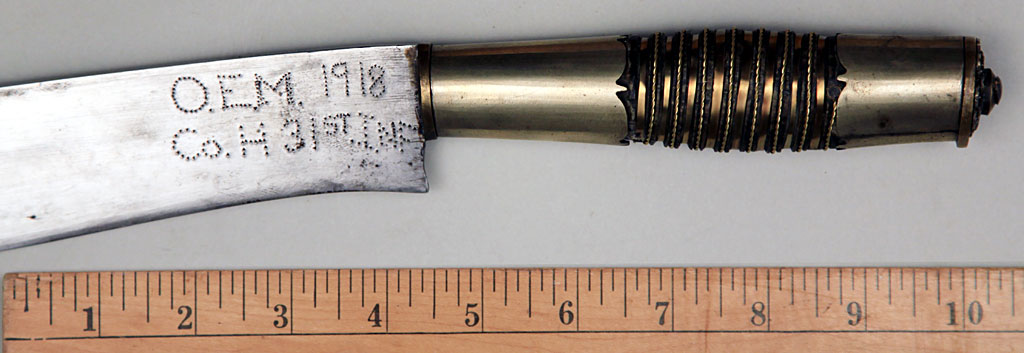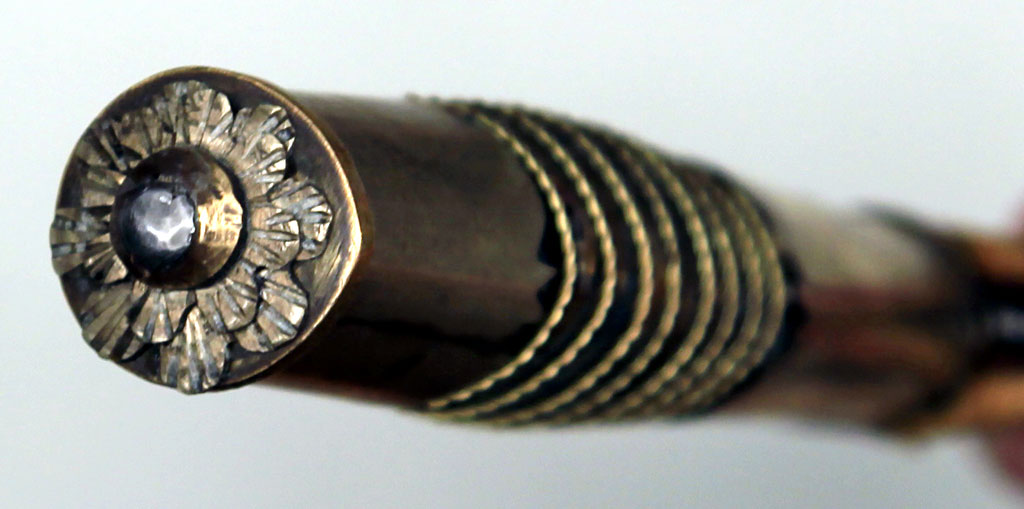
 |
|
|
#1 |
|
Vikingsword Staff
Join Date: Dec 2004
Location: The Aussie Bush
Posts: 4,197
|
In a recent thread about "Negrito" knives and bolos we talked about some of the knives shown in a figure from Fox's article The Pinatubo Negrito (1947). Of particular note was the hundang and its distinctive wooden scabbard. This knife is a common weapon of the Negrito as well as a general utility knife.
Another recent thread provided information about the dipalata, a less common fighting knife used by the Negrito. Another uncommon Negrito fighting knife is the katana, which is also pictured in Fox, figure 9 (see attached). The katana is a narrow bladed large knife/short sword with a distinctive blade profile and a tang set toward the back of the blade. The close similarity of the illustrated example of a katana in Fox and the more familiar Ilocano tabak is probably more than coincidental. Although accomplished smiths, the Negritos have been a longstanding iron poor culture, with the result that they acquired iron and iron objects (including blades) from neighboring ethnic groups. This is mentioned specifically by Fox. It seems very likely that the Negrito katana is adapted from, and in some cases is actually, an Ilocano tabak. To illustrate this more fully, two Ilocano tabak are shown below the figure from Fox. The two characteristically Ilocano hilts on these knives differ from the one illustrated by Fox, which is a more traditional Spanish-style three part hilt. It appears that the Negrito katana and the Ilocano tabak are essentially the same knife, and it is quite possible that the Negrito knives were tabak blades acquired from the neighboring Ilocano. Ian Last edited by Ian; 3rd April 2017 at 07:01 AM. |
|
|

|
|
|
#2 |
|
Member
Join Date: Dec 2004
Posts: 737
|
Beatiful post !!! reciently I have sold similar piece.
Thanks Carlos |
|
|

|
|
|
#3 | |
|
Member
Join Date: Aug 2007
Location: Germany, Dortmund
Posts: 8,770
|
Quote:
thank you for bringing up this interesting topic. I agree with you that the Negrito katana is the same knife as the Ilocano tabak but it seems that the Negritos designed their own scabbard style for this knife. Regards, Detlef |
|
|
|

|
|
|
#4 | |
|
Vikingsword Staff
Join Date: Dec 2004
Location: The Aussie Bush
Posts: 4,197
|
Quote:
|
|
|
|

|
|
|
#5 |
|
Vikingsword Staff
Join Date: Dec 2004
Location: The Aussie Bush
Posts: 4,197
|
Carlos:
Thanks very much for posting your picture. Looks like another nice example of an Ilocano tabak in its leather sheath. This one could be older judging from the three-part Spanish hilt. Ian. |
|
|

|
|
|
#6 |
|
Vikingsword Staff
Join Date: Dec 2004
Location: The Aussie Bush
Posts: 4,197
|
Here is a link to another example from Lew Waldman's Collection posted on this web site. The hilt on this one is very similar to the illustration in Fox's article.
Ian.       
|
|
|

|
|
|
#7 |
|
EAAF Staff
Join Date: Dec 2004
Location: Louisville, KY
Posts: 7,219
|
I always thought that these tabak were Pampangan in origin and not Ilocano.
 Here is a link to what I am talking about: http://www.vikingsword.com/vb/showthread.php?t=3464 Last edited by Battara; 8th April 2017 at 01:23 AM. |
|
|

|
|
|
#8 |
|
Vikingsword Staff
Join Date: Dec 2004
Location: The Aussie Bush
Posts: 4,197
|
Hi Jose:
Your question raises a few important points, and I want to take a little space to discuss Ilocano knives and their description by that ethnic group, and also make a few comments about Pampangan knives. First, why are the knives that are shown here Ilocano? In a very helpful post on this site in 2010, migueldiaz provided some key information and an important reference about Ilocano knives (see here). In that thread he posted the following pictures and descriptions of Ilocano knives (the examples were modern made knives but come from a long tradition of similar knives). Apparently, the Ilocano nomenclature he provides was based largely on the hilt style, and he provides the names for a dozen different styles. Here are the Ilocano terms for those styles: kinakandon: a blade which form was inspired by the palay (rice plant) leaf => am still getting a photo of this blade [Comment: this blade style is called dahong palay and is discussed elsewhere on this site along with pictures of examples with this blade style--see here, here, and here]And here is his picture illustrating some of these types of knives: http://www.vikingsword.com/vb/attach...id=60025&stc=1 If you look at the examples of tabak knives shown here, you will see that each has a hilt that fits with the descriptions provided by migueldiaz. Of particular interest is the first example I showed in the original post of this thread. It would be called a sinan-kapitan, and as far as I know this particular depiction of an officer wearing a cap is uniquely Ilocano. The second example I showed would be called a sinan-sabong. Your example, shown in the thread that you linked, shows a spirally wired hilt, and might be what migueldiaz describes as a linipit. This collective evidence argues, I think persuasively, that the tabak knife is mainly an Ilocano weapon/tool. Whether it is also produced by Pampangans is not clear, and we actually know very little about the knives of Pampangas. Apart from the knives marked as coming from Apalit, I have found relatively little information about the knives of Pampangas. To some extent the identification of knives specific to the Pampangans has been complicated by the presence of the U.S. Clark AFB in the Province. In threads elsewhere on this site, we have seen that Ilocano knives were marketed extensively to U.S. servicemen from the mid-1940s until the base closed in 1991 following the eruption of Mt. Pinatubo. The base was only three miles from the city of Angeles that sits on the main north-south highway in Central Luzon. It is only 30 miles along this highway from Angeles to the Province of Pangasinan, which has a large population of Ilocanos. It would be a short trip to bring knives from Pangasinan to Angeles for sale to the Americanos. It is also possible that Ilocanos took up residence in Angeles and made knives there. This raises an important consideration in how we reference knives like these. Do we attribute them to the culture of origin or the place where they were acquired? If we choose the culture of origin, then the tabak appears to be an Ilocano weapon/tool. If we reference these to where they were likely purchased or otherwise acquired, then they could be considered Pampangan. Hope this is helpful. Ian. ----------------Attachment---------------- Here is the picture from the thread of migueldiaz showing various Ilocano knives and their distinguishing hilt shapes. . Last edited by Ian; 9th April 2017 at 12:00 AM. Reason: Added pic and some more comments, links |
|
|

|
|
|
#9 |
|
Vikingsword Staff
Join Date: Dec 2004
Location: The Aussie Bush
Posts: 4,197
|
I was at a gun show here in Minnesota a couple of weeks ago and came across another example of this sword form. This one has a horn grip with brass ferrules, and the blade has the usual "Negrito katana" shape. The photograph shows the "as found" state of this one, with a heavily patinated blade. I would say probably mid-20th C. Could be Ilocano or Pampangan in manufacture--the hilt on this one looks more Tagalog than Ilocano in style.
Ian . |
|
|

|
|
|
#10 | |
|
EAAF Staff
Join Date: Dec 2004
Location: Louisville, KY
Posts: 7,219
|
Quote:
|
|
|
|

|
 |
|
|